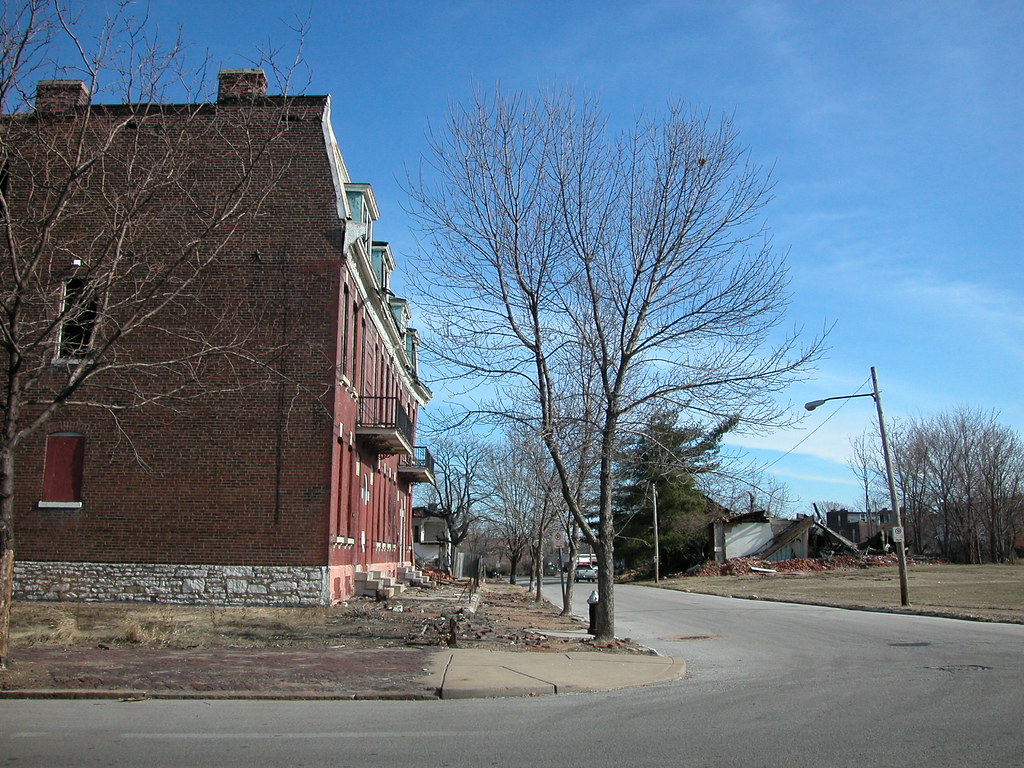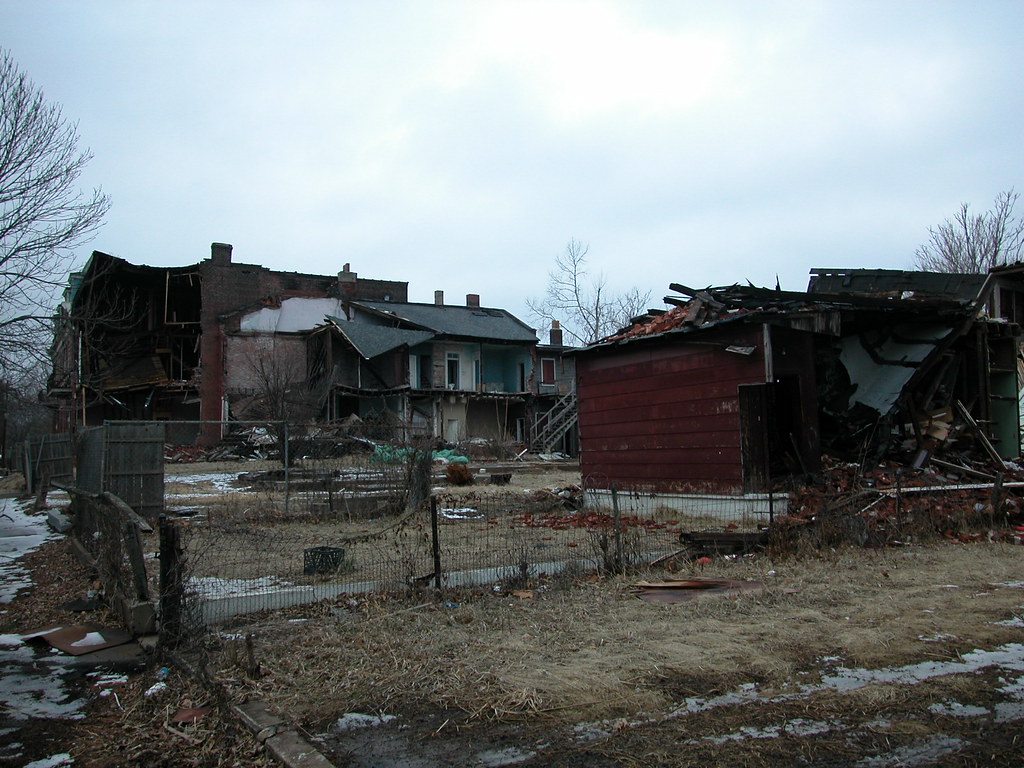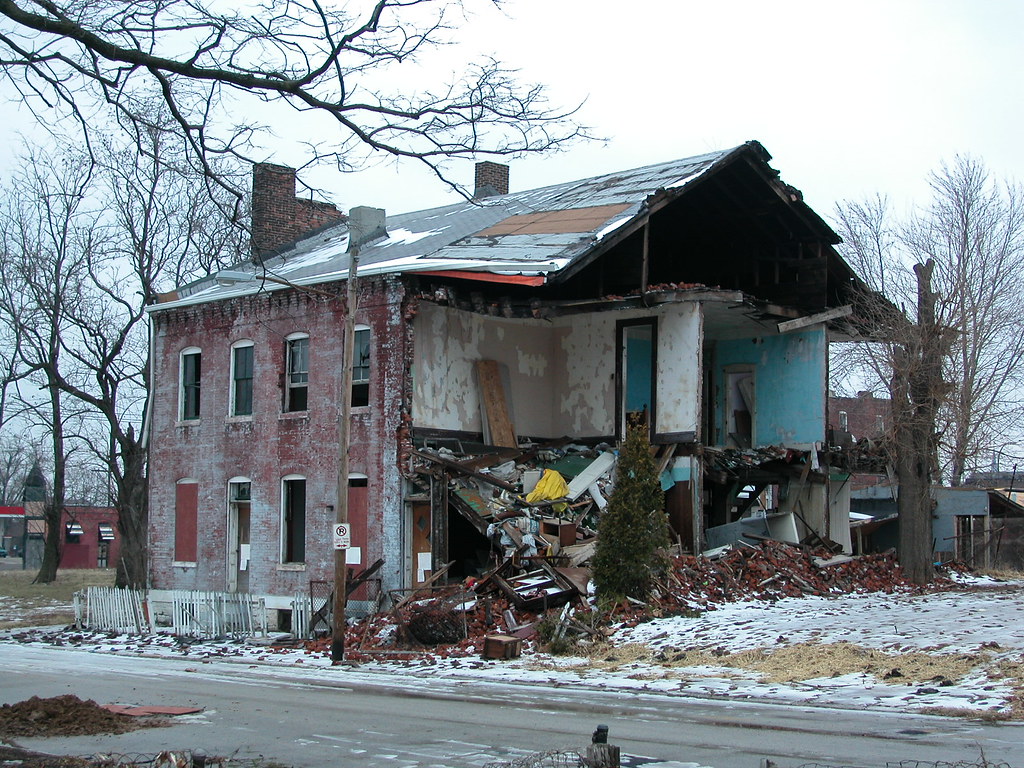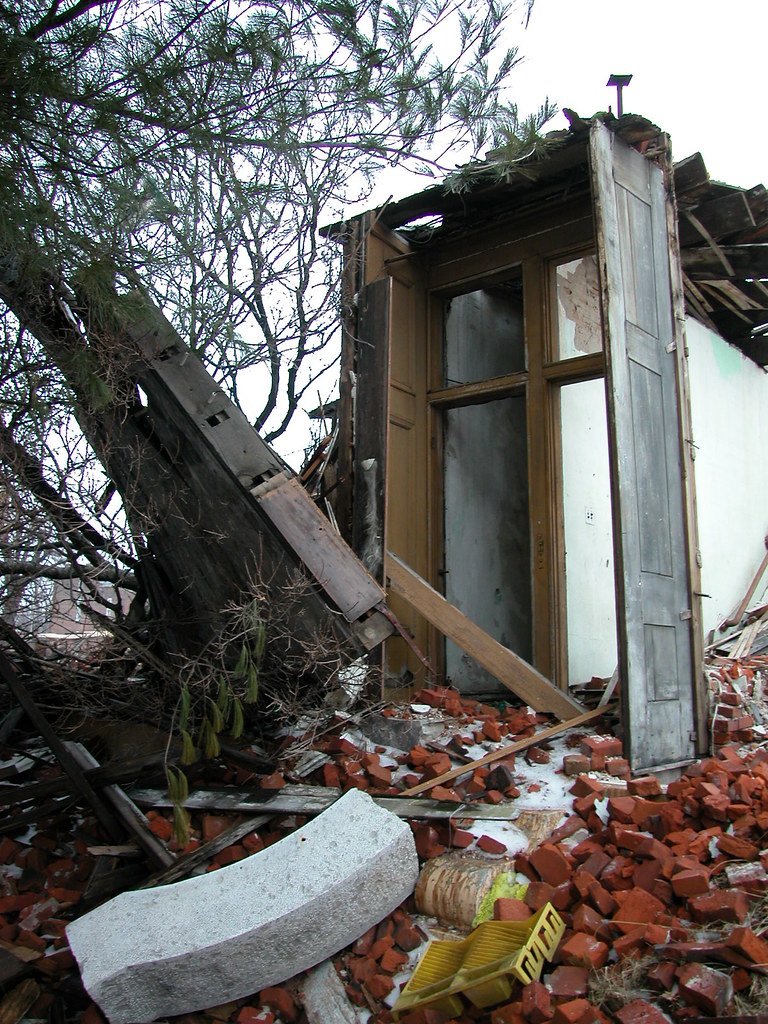 Five years ago, almost every residential unit on the 1900 block of Wright Street in St. Louis Place was occupied. These units were rentals in conditions ranging from good to poor. None of this housing was rehabilitated, but the buildings on the block were in solid condition with average deterioration for their age.
Five years ago, almost every residential unit on the 1900 block of Wright Street in St. Louis Place was occupied. These units were rentals in conditions ranging from good to poor. None of this housing was rehabilitated, but the buildings on the block were in solid condition with average deterioration for their age. The buildings formed a balanced array of different vernacular styles. On the south side of the street, east of a vacant lot, was a brick-faced, mansard-roofed, three-story former single-family home. That house was vacant. East of that, a side-gabled two-story two-flat. East of there was a row of flats -- two stories with attic, side-gabled brick with striking and simple details.
The buildings formed a balanced array of different vernacular styles. On the south side of the street, east of a vacant lot, was a brick-faced, mansard-roofed, three-story former single-family home. That house was vacant. East of that, a side-gabled two-story two-flat. East of there was a row of flats -- two stories with attic, side-gabled brick with striking and simple details.
Across the street was a flat-roofed two-flat probably built a little later than its neighbors. (See photgraphs of this side of the block before rustling.) This building had a Romanesque Revival arched window on the first floor and a dentillated tin cornice above terra cotta garlands. To the west was a two-story alley house reconfigured to face Wright Street, probably after the demolition of the house that stood in front of it.

 West of that, another house set back -- three stories, dormer on the front of the roof, corbeled brick cornice. That house stood next to a few vacant lots. Completing the north street face was a three-story half-flounder two-flat with a front dormer. The house had brick corbels at its cornice, perhaps replacing an earlier wooden cornice. This house was very typical of late 19th century vernacular tenement buildings in the city. It shared a wall with the block's crown jewel, a three-story row of flats with mansard roofs, cast iron balconies, detailed limestone keystones and decorative brickwork.
West of that, another house set back -- three stories, dormer on the front of the roof, corbeled brick cornice. That house stood next to a few vacant lots. Completing the north street face was a three-story half-flounder two-flat with a front dormer. The house had brick corbels at its cornice, perhaps replacing an earlier wooden cornice. This house was very typical of late 19th century vernacular tenement buildings in the city. It shared a wall with the block's crown jewel, a three-story row of flats with mansard roofs, cast iron balconies, detailed limestone keystones and decorative brickwork. The block's architecture was amazing, yet typical of the stock of the near north side. The conditions of the buildings were likewise typical. The block needed improvement, and the houses rehabilitation, but in many ways the block was doing a lot better than most in the neighborhood.
The block's architecture was amazing, yet typical of the stock of the near north side. The conditions of the buildings were likewise typical. The block needed improvement, and the houses rehabilitation, but in many ways the block was doing a lot better than most in the neighborhood.Then, in 2005, came an investor from St. Charles County. Not Paul McKee, but another notorious large-scale developer named Doug Hartmann. Hartmann bought the ornate row on the north side of the street, relocated the tenants and started rehabbing the building. Then his mortgage scheme caught up with him, work stopped, and the building sat open and empty.
Later that year, the other big developer came to the block. McKee's holding companies started with the flat-roofed house and evicted the tenants. The holding companies took another 18 months to acquire the rest of the block, save Hartmann's property and the vacant house. Everyone moved out. A small glimmer of hope emerged when the titles to Hartmann's properties were cleared and some of his investors acquired the row, but no work resumed. Last spring, illegal dumping started at one of the McKee houses (see my post "Silence is Golden" from May 2007). Then a plague descended on this block and all over St. Louis Place -- brick thieves.
Never before had north city seen such a geographically-concentrated amount of brick rustling. Brick rustling is the activity in which unlicensed workers demolish abandoned properties solely to steal the bricks and sell them to brick yards for quick cash. What happened on Wright Street happened on Montgomery, St. Louis, Coleman, Garrison and many other streets in St. Louis Place and Jeff VanderLou. The rustling began in early 2007 and continues to this day. The targets seem to primarily be McKee-owned property. While the buildings are easy opportunities, and many of these buildings had been occupied only recently and thus unavailable for rustling, the timing has prompted much suspicion of a concerted effort on someone's part.
Earlier this year, the thieves had made their way through most of the buildings. The flat-roofed building and the exquisite row were standing intact until this February, when rustlers hit hard and fast, taking out pivotal front corners. For some reason, the thieves didn't tackle the alley house. On a vacant block, brick rustling goes undetected. Even when someone sees it happening, chances are good that the person will dismiss the work as legitimate -- or simply not care. Those who do need to call 911 at every instance; some reported instances have indeed led to arrests of theieves.
In February, Alderwoman April Ford-Griffin (D-5th) responded to the situation on this block by ordering emergency demolition of all of the buildings, including the alley house. Demolition is nearly complete. Who can blame her? With no hope for the buildings, their condition posed a public safety hazard as well as a sign of neglect. No one wants to live near the spectacle of a group of rustled buildings -- it's a frightening sight, one that drives visitors and homeowners alike to prettier places. The rewards of rustling to the thieves are small and immediate, but the reward to anyone wanting to buy out more residents of St. Louis Place is large and enduring.
The irony is that under the Distressed Areas Land Assemblage Tax Credit, McKee can receive tax credit money for the emergency demolition work that Alderwoman Ford-Griffin ordered, should he pay his bills before applying. Demolition work is reimbursed 100% by the credits. Attractive nuisances, indeed.

Additional coverage is available at St. Louis Patina: "St. Louis Place Blockbusting" (March 8, 2008) and "I Would Have Lived There" (March 6, 2008).





9 comments:
This just breaks my heart. Between your Blairmont coverage and Rob Powers' on Built St. Louis, I have lost nearly all patience with any political structure that sits idly by--and, worse yet, acquiesces and condones--as the last assets of struggling north side neighborhoods disappears. Drained of their bodies and buildings, these neighborhoods are dying and are soon to be deceased forever. The evidence is too strong. What can I do? What can we do?
Yes, children once lived here.
The buildings may have been a public safety hazard, however with leadership and proactive initiative perhaps they wouldn't have reached such a state?
Ford-Griffin shouldn't be given a pass. Her contributions from McKee, dating back to 2003, explain why this came to pass. Without outside attention, she wouldn't have brought this issue on the agenda. If not for certain individuals this systemic cancer could have spread even more.
She admitted that she noticed a change in her neighborhood yet her only solution is to demolish the buildings thus make that change irrevocable. The proper response would have been community mobilization at the onset along with media attention.
In this situation at the worst we have collusion and the best negligence bordering on dereliction of duty. Either is unacceptable especially in St. Louis' disadvantaged neighborhoods which need the most attention and leadership.
A lot of the problems we see in cities are the result of global or national policies which an alderman cannot control. But this is a situation where an alderman is able to make a direct observable impact through leadership. Unfortunately that didn't happen. Our neighbors and the built environment pay the price.
I've seen damage that appears to be brick rustling on Evans (a short street between Page and Dr. King). I don't think McKee owns properties over there. I wonder if he pays thieves to dismantle his north side properties, or if they already have enough incentive since they can make money for the bricks and the owner doesn't care if his property falls down.
Your photos are horrifying.
I wonder the same thing as Matt. What are some potential solutions to the brick rustling problem? Some of us are aware of it, but what can we do? And do the police care about this crime at all? Are they aware of the extent of the problem? Would they bother to investigate it? I'm guessing it's not legal to secure someone else's unsecured property. Do we know who buys the stolen bricks, and if those people know the bricks have been stolen? Is it true that the bricks get sent to other cities, like New Orleans, as Sam Moore has said? I have so many unanswered questions about this issue.
Sounds like this is the issue du jour for Drinks and Mortar this evening.
There are residents in the 5th and 19th wards that are working together with Sts Teresa and Bridget church's Social Justice Committee If anyone would like to join us you can email me @ srendon98@yahoo.com. All are welcome we are trying to organize the neighborhood to work more effectively against the disrespect and the systematic destruction of our wards. All are welcome. Please join us.
Sheila Rendon
Sts T&B Social Justice Committee
I'd just like to add that photographs of many of these houses from when they were intact can be seen at Built St. Louis.
In response to Doug Duckworth
"... Ford-Griffin shouldn't be given a pass. Her contributions from McKee, dating back to 2003, explain why this came to pass... her only solution is to demolish the buildings thus make that change irrevocable...we have collusion and the best negligence bordering on dereliction of duty.
Doug,
Thanks for the apparent outing of Ms Ford-Griffin. No wonder I never received a response to my sincere questions about returning to St Louis and reclaiming an older City-Owned home! We might find these videos on You Tube interesting.
http://www.youtube.com/watch?v=yOKtIaGmpN8&videos=KWLDD5lG_MQ&playnext_from=TL&playnext=1
Post a Comment